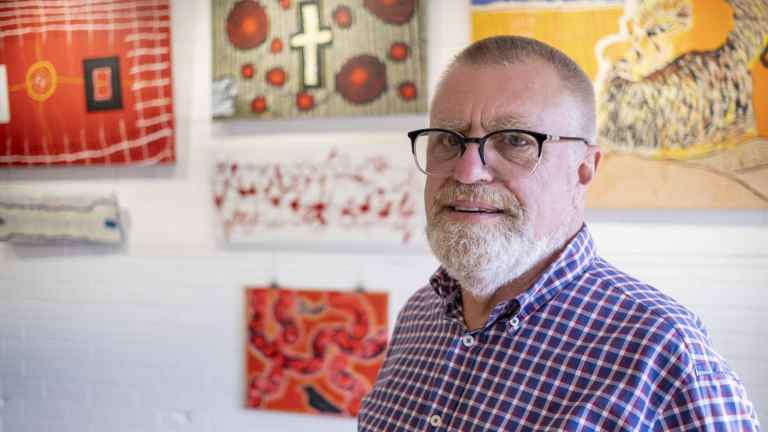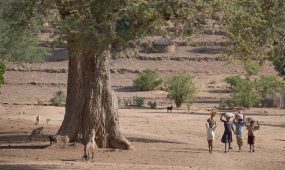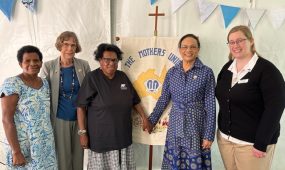A daily memorial to the costs of dispossession
News
An online monument acknowledging the violent dispossession of Aboriginal peoples features a daily format, partly inspired by the Anglican and Catholic daily reflective offerings. ACSQ Anglican priest The Rev’d Dr Ray Barraclough has compiled the website, which features artwork from Melbourne Anglican priest and Wiradjuri artist The Rev’d Glenn Loughrey

AN ONLINE monument acknowledging the violent dispossession of Aboriginal people features a daily format, partly inspired by the Anglican and Catholic traditions daily reflective offerings.
So That We Remember provides a daily calendar of excerpts from historical sources and modern historians’ work on Australia’s history of colonialism and the consequences of this for First Nations peoples.
Its creators hope that the daily format will bring the painful history into the public eye.
Queensland-based Anglican priest Reverend Ray Barraclough has compiled the website, which features artwork from Melbourne Anglican priest and Aboriginal artist Reverend Glenn Loughrey.
Dr Barraclough said the project was partially spurred on by a line from historian Mark McKenna’s Quarterly Essay, in which he noted there were no official state monuments commemorating the death and dispossession inflicted on First Nations peoples after white settlers arrived.
He said the format was partly inspired by the daily offerings of the Anglican and Catholic traditions.
“In compiling So That We Remember, we offer it as a daily memorial to the cost to Indigenous lives in the emergence of contemporary Australia,” he wrote on the website.
“Those lives deserve to be remembered. The consequences of that colonisation process are still with us. There are no exits from the realities of this history.”
Speaking to The Melbourne Anglican, Dr Barraclough said the goal for the project was to get this painful history into the public eye and hopefully reduce ignorance towards Aboriginal and Torres Strait Islanders.
Advertisement
He said he hoped fellow Australians could grasp that when they had a traumatised people as part of their national community, they needed to acknowledge their experience and their history.
“Most Australians have anecdotal understandings of Indigenous people,” he said.
“The main public consciousness is related to the individuals, the individualisation, rather than being aware of what are the consequences for a traumatised people.
“A community or a country needs to give attention to this, because it needs healing, and it needs hearing within the ears of the nation itself.”
Mr Loughrey said Dr Barraclough had approached him about using his artwork several years ago, when the project was initially slated to be released as a book. He said he was happy to open up his archive of paintings for the project.
“You don’t create art to keep it home in the cupboard. If it’s in synergy with the project and it can speak something new and different into that project, can enunciate something about the project, then I think it’s worthwhile doing,” he said.
Advertisement
“A lot of my art is about this story, so it’s easily taken and put into this place.”
Mr Loughrey said his work drew on these themes of violence and dispossession of First Nations people in Australia because his creativity came out of corporeal experience.
“For Aboriginal people the corporeal experience has been one of dispossession and violence,” he said.
“That’s what we all have carried because of damage to country, damage to people, people not being able to identify as Aboriginal, loss of language, all of that.
“This story sits at the bottom of our self-awareness and our self-expression and our consciousness about ourselves and how the western world sees us.”
Mr Loughrey and Dr Barraclough both agreed that creating the project as a website increased its potential to reach a wider audience, which made it more effective as a tool to further understanding and reconciliation.
“We can have truth telling exercises but they’re very limited in how they reach people,” Mr Loughrey said.
“If we want to talk seriously about doing reconciliation and writing the wrongs from the past, we have to know what they are.
“This document gives you 365 examples of what happened and that fact that it was systemic – it wasn’t just bad people doing bad things. It opens up a whole set of ways into the story who really want to do something constructive.”
Dr Barraclough said he was conscious that the project was entering the “history wars”, and that some might call the focus “passé”. But he said there was no such thing as closure when it came to historical trauma that shapes the future.
“Countries try to close it down, like Turkey with the Armenian massacre, Kampuchea, Indonesia closes it down in regards to the 1965 massacres,” he said.
“There is no closure on this kind of thing. Australian history is haunted by what we’re journeying into.”
He added that the project was a secular piece of work despite his and Mr Loughrey’s connections with the Church, but he hoped Christians would see how their faith had a role to play in this history too.
“We quote bits of religion in the excerpts: some of it is good, some of it is embarrassing,” he said.
“But for those conservative Christians who say Australia was founded on Christian values, I hope they might have a little time to read this history to realise how pretty hollow that runs in terms of real history, not rhetorical history.”
The website was officially launched at the start of December, with more than a month’s worth of daily texts to be added over the coming weeks. You can visit the site at sothatweremember.com.au.
First published in The Melbourne Anglican on 14 December 2021.





